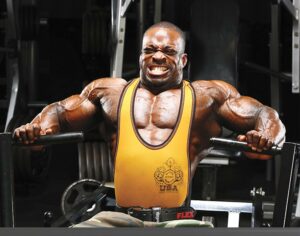For decades, the conventional wisdom in building muscle has been synonymous with lifting heavy weights. Images of bodybuilders straining under massive barbells come to mind, pushing themselves to the limit with each rep. However, recent research suggests there might be a more efficient way to achieve muscle growth – and it doesn’t involve grunting and grinding with heavy weights.
A lot of folks are confused when it comes to building muscle and having that desired physique and many people think they should consider lifting heavy weights to achieve that level BUT the reality is that you don’t need to lift heavy weights to build muscle BUT you have and must exhaust your muscle tissues to the fatigue level. Building muscle is a process of exhausting the muscle tissues and not just lifting heavy to impress folks in the gym.
Let me explain about muscle exhaustion: “Muscle exhaustion is when you hit the gym, choose a certain workout, and train that certain muscle group until it hurts. It makes the blood vessels run fast and it pumps the muscle and the muscle grows when it gets exhausted”. That’s why exhausting the muscle is more important than lifting heavyweights when it comes to building real muscle tissue. we’re gonna cover this topic very carefully in this entire article.
Current gym dogma holds that to build muscle size you need to lift heavyweights. However, a new study conducted at McMaster University has shown that a similar degree of muscle building can be achieved by using lighter weights. The secret is to pump iron until you reach muscle fatigue. “Muscle building can be achieved by using lighter weights to pump iron until you reach muscle fatigue”.
“Rather than grunting and straining to lift heavy weights, you can grab something much lighter but you have to lift it until you can’t lift it anymore,” says Stuart Phillips, associate professor of kinesiology at McMaster University. “We’re convinced that growing muscle means stimulating your muscle to make new muscle proteins, a process in the body that over time accumulates into bigger muscles.”
Phillips praised lead author and senior Ph.D. student Nicholas Burd for masterminding the project that showed it’s really not the weight that you lift but the fact that you get muscular fatigue that’s the critical point in building muscle. The study used light weights that represented a percentage of what the subjects could lift. The heavier weights were set to 90% of a person’s best lift and the lightweights at a mere 30% of what people could lift. “It’s a very lightweight,” says Phillips noting that the 90-80% range is usually something people can lift from 5-10 times before fatigue sets in. At 30%, Burd reported that subjects could lift that weight at least 24 times before they felt fatigued.
“We’re excited to see where this new paradigm will lead,” says Phillips, adding that these new data have practical significance for gym enthusiasts but more importantly for people with compromised skeletal muscle mass, such as the elderly, patients with cancer, or those who are recovering from trauma, surgery or even stroke.
The findings are published in PLoS ONE: www.plosone.org/article/info%3Adoi%2F10.1371%2Fjournal.pone.0012033
This article explores the science behind building muscle and challenges the traditional “heavy weights, low reps” approach. We’ll delve into the concept of muscle fatigue and how it can be a more effective driver of muscle growth than sheer weight lifted. We’ll also explore the benefits of incorporating lighter weights with higher repetitions into your workout routine.
 The Science Behind Muscle Growth
The Science Behind Muscle Growth
Muscle growth, scientifically termed hypertrophy, occurs when muscle fibers are subjected to stress that damages them. The body responds by repairing and rebuilding these fibers, making them larger and stronger. Traditionally, it was believed that only heavy weights could create this level of stress. However, a 2010 study published in PLoS ONE by researchers at McMaster University challenged this notion. The study found that achieving muscle fatigue, regardless of weight used, was the key factor in stimulating muscle growth.
The lead author, Nicholas Burd, explained, “Our findings suggest that it’s really not the weight that you lift but the fact that you get your muscles to fatigue that is important for stimulating muscle protein synthesis.” This protein synthesis is the process by which your body builds new muscle tissue.
Benefits of Lighter Weights and Higher Reps
There are several advantages to focusing on muscle fatigue with lighter weights and higher repetitions:
- Accessibility: Not everyone can safely lift heavy weights. Lighter weights make muscle-building workouts more accessible for beginners, those returning from injuries, and individuals with limitations.
- Reduced Risk of Injury: Using lighter weights with proper form minimizes stress on joints and ligaments, reducing the risk of injuries often associated with heavy weightlifting.
- Improved Mind-Muscle Connection: Focusing on the feeling of the working muscle throughout the entire rep range with lighter weights can help you develop a stronger mind-muscle connection. This heightened awareness can lead to more efficient muscle activation and potentially better results.
- Increased Time Under Tension (TUT): Lighter weights often allow for slower, more controlled movements. This increases the time your muscles are under tension (TUT), which can be a significant growth stimulus.
- Greater Metabolic Stress: Higher repetition workouts with lighter weights can elevate your heart rate and increase metabolic stress, potentially aiding in fat burning and overall fitness.
Check Out Our List Of The Best Supplements For Building Muscle, Shredding Muscle, Recovery, And Great Health, and Wellness Products! Purchase ifbnewsfeed.org‘s apparels Here: ifbnewsfeed.org

 The “Pump” Factor: Reaching Muscle Fatigue
The “Pump” Factor: Reaching Muscle Fatigue
The “pump” you feel during a workout is a sign of metabolic stress and blood accumulation in your muscles. It’s this feeling of fatigue, not necessarily the weight lifted, that triggers muscle growth. Here’s how to achieve muscle fatigue with lighter weights:
1. Choose the Right Weight: The weight should be challenging enough that you can only complete the desired number of repetitions (typically 15-25) with proper form. The final few reps should be a struggle.
2. Focus on Form: Maintaining proper form throughout the entire set is crucial. Don’t sacrifice form to lift more weight.
3. Slow and Controlled Reps: Perform each repetition slowly and with control. Aim for a 2-second eccentric (lowering) phase and a 1-second concentric (lifting) phase.
4. Push to Failure: Continue each set until you reach a point of muscular failure, where you can no longer maintain proper form with the next repetition.
5. Rest and Repeat: Take short rest periods (30-60 seconds) between sets to allow your muscles to recover slightly before pushing them again.
Building a Lighter Weight Workout Routine
Here’s a sample workout routine that utilizes lighter weights and higher repetitions to target different muscle groups:
Warm-up: 5-10 minutes of light cardio and dynamic stretches
- Chest: 3 sets of 15-20 repetitions of dumbbell bench press
- Back: 3 sets of 15-20 repetitions of seated cable rows
- Shoulders: 3 sets of 15-20 repetitions of dumbbell lateral raises
- Legs: 3 sets of 20-25 repetitions of bodyweight squats
- Biceps: 3 sets of 15-20 repetitions of dumbbell curls
- Triceps: 3 sets of 15-20 repetitions of overhead triceps extensions
Cool-down: 5-10 minutes of static stretches
This is just a sample, and you can adjust the exercises, weight, and reps based on your fitness level and goals. Remember, consistency is key to seeing results. Stick to a regular workout routine that incorporates the principles of muscle fatigue with lighter weights.
Wrapping Up
Building muscle doesn’t necessarily require grunting under the heaviest weights. “Training for muscle fatigue, using lighter weights but pushing yourself to complete exhaustion, can be an equally effective way to stimulate muscle growth and achieve your fitness goals”. This approach is beginner-friendly, reduces injury risk, and allows for greater exercise variety, making it a valuable tool for anyone looking to build muscle. Remember, consistency, proper technique, and progressive overload are key to success, regardless of the weight you lift.
 More About Bodybuilding Tips for Beginners and Beyond Guide Contents
More About Bodybuilding Tips for Beginners and Beyond Guide Contents
- The Best Bodybuilding Tips “That Work For Both Men And Women” Including Beginners And Experienced Bodybuilders
- Elevate Your Wellness, Well-being & Health – “Fitness, Training, Nutrition, Exercise, and Bodybuilding”
- “The Cost Of Bodybuilding Competitions”: From Preparation (LifeStyle) To Performance (At The Stage)

- A1Supplements.com – America’s Favorite Supplement Store.
- Shop Optimum Nutrition Energy: Anytime & Pre-Workout
- A1Supplements.com – Lose Fat, Gain Muscle
For More News And Daily Updates, Follow IFBNewsfeed.Org™🇺🇸 on Facebook, Twitter, and Instagram. Comment, Like, And Share With Everyone Who May Need To Be Updated With The Most Recent Fitness/Bodybuilding/Powerlifting And CrossFit News.







